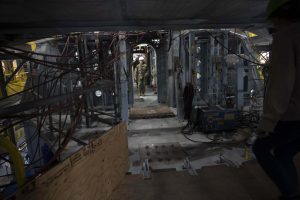At the 2024 Sea-Air-Space defense conference hosted by the Navy League from April 8-10, U.S. Navy leadership and major defense contractor executives convened in a setting more somber than it appeared. The gathering at the Gaylord National Resort and Convention Center, just eight miles due south of the U.S. Capitol, was overshadowed by the results of a damning internal report directed by Secretary of the Navy Carlos Del Toro, which revealed substantial delays across the Navy’s shipbuilding portfolio.
Just days before the Sea-Air-Space conference kicked off, Nickolas Guertin, the Navy’s acquisition chief, presented a sobering acknowledgment to reporters at the Pentagon: “We don’t have detailed plans of action, milestones, initiatives – we are identifying and deeply looking into where we are now in a ‘get real, get better’ approach.”
The urgency of these revelations cannot be overstated. With the U.S. defense budget approaching $1 trillion annually, the imperative for enhanced shipbuilding and maintenance capacity to meet increased demand is critical. Moreover, Admiral Phil Davidson’s warning of potential Chinese aggression toward Taiwan by 2027 – now termed the “Davidson Window” – underscores the strategic vulnerabilities these delays could exacerbate.
Recent reviews have highlighted significant postponements in several big-ticket programs, including the first Columbia-class submarine, the new block of the Virginia-class submarine, the USS Enterprise aircraft carrier, and the first Constellation-class frigate, with projections extending delays by up to three years. The Columbia-class submarines, critical to U.S. nuclear deterrence and consistently identified as the Navy’s top priority program, face a one-year delay to 2028, potentially destabilizing the strategic equilibrium in the Pacific.
This is no longer an issue of delayed timelines; it has become a strategic liability.
The underlying cause of these setbacks is what Nobel Laureate Daniel Kahneman identified as the planning fallacy. This cognitive bias, which prompts decision-makers to underestimate risks and overestimate benefits, often impairs judgment and could negatively impact national security. In this context, systemic optimism has skewed rational decision-making processes surrounding the Navy’s shipbuilding portfolio, distorting the realistic assessment of available warfighting capabilities and force structure timelines over the next decade.
To effectively mitigate inherent optimism in strategic projects, the U.S. Navy should adopt what Kahneman described as an “outside view.” This methodological shift employs reference class forecasting, which involves identifying and critically analyzing a set of similar programs and using empirical distributional information to de-bias estimates and calculate the likeliest outcome. By anchoring program planning in empirical reality rather than the subjective biases inherent in an “inside view,” this approach more accurately aligns expectations with the complex realities of major new shipbuilding programs.
Today, reference class forecasting has proven to be an effective intervention technique in the assessment of large-scale programs – it is utilized across Europe (in the United Kingdom, Denmark, Germany, Norway, Sweden, Switzerland, and the Netherlands). Perhaps the most notable example of this practice is found in the United Kingdom, where the Treasury’s Green Book provides comprehensive guidelines for evaluating policies, programs, and projects to account for uncertainty, optimism bias and risk. This guide mandates that planners apply percentage adjustments – or an “uplift” – to the estimates of costs and schedule durations to explicitly account for optimism bias. This policy ensures that budgetary and scheduling plans are more aligned with historical data and less susceptible to the whims of overly optimistic projections.
As tensions between China and Taiwan escalate, it is crucial for the U.S. Navy to adopt an informed, empirically grounded framework to ensure reliable, timely, and cost-effective design, construction, and maintenance of ships, submarines, and systems. By embracing Kahneman’s approach and adopting an “outside view,” the U.S. Navy can implement the bold strategies necessary to turn around its shipbuilding programs and make informed investments within the defense industrial base. This will not only help get key Navy programs back on track but also continue to anchor the United States in the Indo–Pacific, strengthening the region in the process.

































